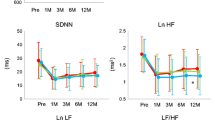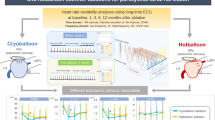Summary.
Patients with paroxysmal atrial fibrillation have a lower chemoreflex sensitivity (CHRS) which is characterized as an autonomic dysfunction. Because of this observation we examined the theory of an autonomic dysfunction as the reason for the recurrence of atrial fibrillation after electrical cardioversion.
Method:
We measured the CHRS among 43 patients 24 h after successful electrical cardioversion and the patients were controlled for at least 6 months.
Results:
During the six months of follow-up a recurrence was observed in 18 patients with a mean of 8.3 days. There was no difference in organic heart disease or in the use of drugs. Left atrial diameter was not significantly larger in patients with a recurrence. Patients with a recurrence have a significantly lower CHRS than patients with sinus rhythm (2.41 ± 1.82 vs 5.62 ± 3.02 ms/mmHg, p < 0.04). The diagnostic value of a CHRS below 3.0 ms/mmHg achieved a specificity of 68%, a sensitivity of 67%, a positive and negative predictive value of 60% and 74%.
Conclusions:
An analysis of CHRS seems to be an appropriate method to predict a recurrence of atrial fibrillation. The predictive power of the method has to be examined by prospective investigations of a larger patient population and a longer follow-up.
Zusammenfassung.
Eine erniedrigte Chemoreflexsensitivität (CHRS) als Ausdruck einer autonomen Dysfunktion wurde bei Patienten mit paroxysmalem Vorhofflimmern nachgewiesen. Aufgrund dieser Beobachtung untersuchten wir die Theorie einer autonomen Dysfunktion als Ursache eines Rezidives von Vorhofflimmern nach elektrischer Kardioversion.
Methodik:
Die Messung der CHRS wurde bei 43 Patienten 24 h nach erfolgreicher elektrischer Kardioversion durchgeführt, und die Patienten wurden für mindestens 6 Monate nachbeobachtet.
Ergebnisse:
Im Verlauf von 6 Monaten wurde bei 18 Patienten ein Rezidiv im Mittel nach 8,3 Tagen beobachtet, wobei kein Unterschied in der medikamentösen Therapie oder bei den kardialen Erkrankungen bestand. Die Größe des linken Vorhofes war nicht signifikant vergrößert bei den Patienten mit Rezidiv. Die CHRS war signifikant niedriger bei Auftreten eines Rezidives von Vorhofflimmern im Vergleich zum kontinuierlichen Sinusrhythmus (2,41 ± 1,82 vs. 5,62 ± 3,02 ms/mmHg, p < 0,04). Bei Festlegung einer erniedrigten CHRS bei 3 ms/mmHg wurde eine Sensitivität von 67% mit einer Spezifität von 68% erreicht. Der positive prädiktive Wert betrug 60% bei einem negativen prädiktiven Wert von 74%.
Schlussfolgerungen:
Die Analyse der CHRS scheint als Methode zur Erfassung eines Rezidives von Vorhofflimmern geeignet zu sein. Jedoch sind weitere Untersuchung an einem großen Patientenkollektiv mit einer längeren Nachbeobachtungszeit noch notwendig, um diese Ergebnisse zu untermauern.
Similar content being viewed by others
Author information
Authors and Affiliations
Corresponding author
Rights and permissions
About this article
Cite this article
Budeus, M., Hennersdorf, M., Perings, C. et al. Die Prädiktion des Rezidives von Vorhofflimmern nach elektrischer Kardioversion mit der Chemoreflexsensitivität. Z Kardiol 93, 295–299 (2004). https://doi.org/10.1007/s00392-004-0052-x
Received:
Accepted:
Issue Date:
DOI: https://doi.org/10.1007/s00392-004-0052-x




